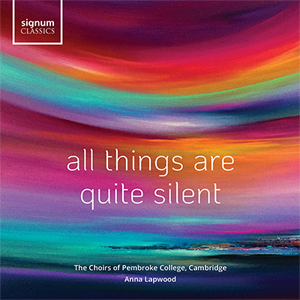Choral music fans are well acquainted with a handful of elite choirs based within the colleges of England’s University of Cambridge, the usual suspects being Trinity, St. John’s, King’s, Clare, Magdalene. But occasionally a recording by a less-familiar Cambridge choir turns up among some new releases–and with something like 29 different colleges, most with some kind of choir, many of them chapel choirs with long and esteemed traditions, it’s not unreasonable to discover that there are several other very fine ensembles doing excellent work within the confines of that vast Cambridge choral complex.
In this case, it’s Pembroke College, which happens to be the third oldest of the Cambridge institutions (1347), but whose choir is as up-to-date as any first-rate modern ensemble while maintaining ties to the revered repertoire and sacred choral traditions of past centuries. The choir does outreach work on its tours, to such places as Thailand and Zambia, as well as in its home territory, and performs at regular services and seasonal concerts. All of this activity is under the guidance of music director Anna Lapwood, whose own resumé is quite extraordinary–organ, harp, viola, voice, conductor, classical radio broadcaster, music educator, composer–and who, only in her mid-20s, at Pembroke commands not only the Chapel Choir, but also the Pembroke College Girls’ Choir (ages 11 to 18), both of which are heard on this recording, which is the “first commercial release” both for conductor and choirs.
Much of the repertoire here is by modern, or modern-ish, composers who have a particular interest in and affinity for choral writing. Names such as Elizabeth Poston, Jonathan Dove, and Eleanor Daley will be very familiar to choir fans–as will Sally Beamish, Caroline Shaw, Imogen Holst, and Amy Beach be more recognizable to almost all listeners. We also hear pieces by several lesser-known composers as well as a motet by Josef Rheinberger, which, along with an arrangement of a song by R&B singer Laura Mvula seem a little out of place alongside the rest of the program.
No matter; the singing is excellent throughout, by both the girls’ choir and the mixed chapel ensemble. Intonation, ensemble technique, and balances, especially bass/soprano in the mixed choir, are a joy to experience. A surprise–and a highlight of the disc–is Poston’s The Water of Tyne, a piece of which I (and I presume many others) was not aware, given that the only one of her works anyone ever knows or sings is the ever-popular Jesus Christ the Apple Tree (a beautiful performance of which is also included here). Other highlights are the vibrant and affecting setting of O nata lux by director Anna Lapwood, Beamish’s straightforward yet very lovely In the Stillness, Matthew Martin’s simple and moving Justorum animae, Daley’s evocative Grandmother Moon, and even a work by Amy Beach, of whom I’ve never been a fan, but whose Peace I Leave with You keeps me coming back. Lapwood’s detailed liner notes complete this strongly recommended package.
































